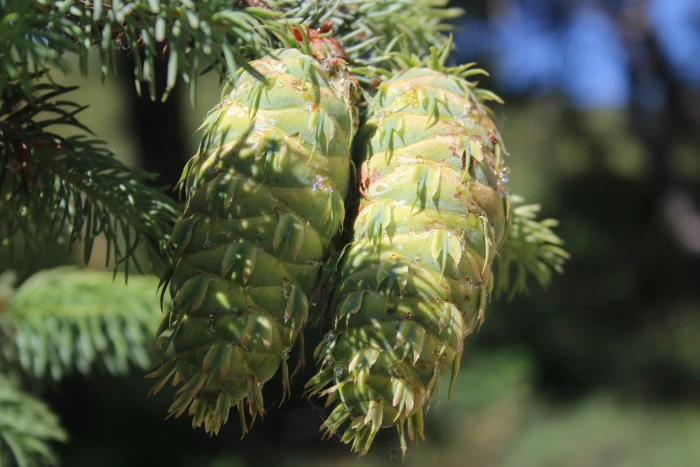Bigcone Douglas-Fir
(Pseudotsuga macrocarpa)
Bigcone Douglas-Fir (Pseudotsuga macrocarpa)
/
/

Joe Decruyenaere
CC BY-SA 2.0
Image By:
Joe Decruyenaere
Recorded By:
Copyright:
CC BY-SA 2.0
Copyright Notice:
Photo by: Joe Decruyenaere | License Type: CC BY-SA 2.0 | License URL: https://creativecommons.org/licenses/by-sa/2.0/ | Uploader: joedecruyenaere | Publisher: Flickr |






















































Estimated Native Range
Climate Requirements for Midlothian, Texas
| This Plant | Your Site | Plant Suitability for Your Location | ||
|---|---|---|---|---|
| • Precipitation | 20" - 31" | 36" | Aquatic | Aquatic |
| • High Temp. | 81°F - 89°F | 95°F | Your summer temperatures are normal for this plant. | Excellent |
| • Low Temp. | 29°F - 39°F | 34°F | Your winter temperatures are normal for this plant | Excellent |
This plant may not grow well at your location - your precipitation is too high.
Summary
Pseudotsuga macrocarpa, commonly known as Bigcone Douglas-Fir, is an evergreen tree native to the mountainous regions, including the San Gabriel and San Bernardino Mountains, and the chaparral and closed-cone pine forest ecosystems of Southern California. It can reach heights of 15–30 m (49–98 ft) with a trunk diameter of 56–155 cm (1 ft 10 in – 5 ft 1 in). The tree’s form is straight with a conical crown that spans 12–30 m (39–98 ft) broad. The bark is thick and deeply furrowed, providing protection from fire, which is common in its native habitat. The branches are long and spreading, with pendulous side shoots, and the tree has a strong and spreading root system. The cones are particularly large and distinctive, hence the name "Bigcone." The seeds are adapted for dispersal by birds and mammals, as the small wings are not effective for wind dispersal. Trees begin producing seeds at about 20 years of age.
Bigcone Douglas-Fir is valued for its ability to thrive in dry, mountainous regions, making it suitable for similar climates in cultivation. It is often used for reforestation projects and as an ornamental tree in large spaces due to its imposing size and attractive form. It is shade-tolerant and prefers to grow on slopes, which makes it a good choice for hillside planting to help control erosion. In cultivation, it requires part shade, low amounts of water, and well-drained soils. While it is not commonly found in the nursery trade, it can be a unique addition to a native plant garden or natural landscape. Potential problems include susceptibility to Douglas-fir beetle and root rot in poorly drained soils.CC BY-SA 4.0
Bigcone Douglas-Fir is valued for its ability to thrive in dry, mountainous regions, making it suitable for similar climates in cultivation. It is often used for reforestation projects and as an ornamental tree in large spaces due to its imposing size and attractive form. It is shade-tolerant and prefers to grow on slopes, which makes it a good choice for hillside planting to help control erosion. In cultivation, it requires part shade, low amounts of water, and well-drained soils. While it is not commonly found in the nursery trade, it can be a unique addition to a native plant garden or natural landscape. Potential problems include susceptibility to Douglas-fir beetle and root rot in poorly drained soils.CC BY-SA 4.0
Plant Description
- Plant Type: Tree
- Height: 60-80 feet
- Width: 30-40 feet
- Growth Rate: Moderate
- Flower Color: N/A
- Flowering Season: Non-Flowering
- Leaf Retention: Evergreen
Growth Requirements
- Sun: Part Shade
- Water: Low
- Drainage: Fast, Medium
Common Uses
Bird Garden, Butterfly Garden, Low Maintenance
Natural Habitat
Native to mountainous regions and closed-cone pine forests of Southern California
Other Names
Common Names: Bigcone Spruce, Large-Coned Douglas-Fir, Big-Cone Douglas-Fir, Big-Cone-Spruce, Großfrüchtige Douglasfichte, Großfrüchtige Douglasie, Großfrüchtige Douglastanne, Douglas De San Bernardino, Douglas À Grands Cônes, Douglas À Gros Cônes
Scientific Names: Pseudotsuga macrocarpa, Tsuga macrocarpa, Pseudotsuga californica, Abies macrocarpa, Pseudotsuga douglasii var. macrocarpa, Abies douglasii var. macrocarpa, Pseudotsuga menziesii subsp. macrocarpa
GBIF Accepted Name: Pseudotsuga macrocarpa (Vasey) Mayr